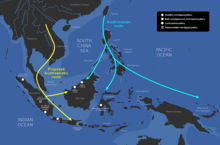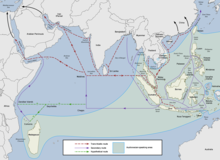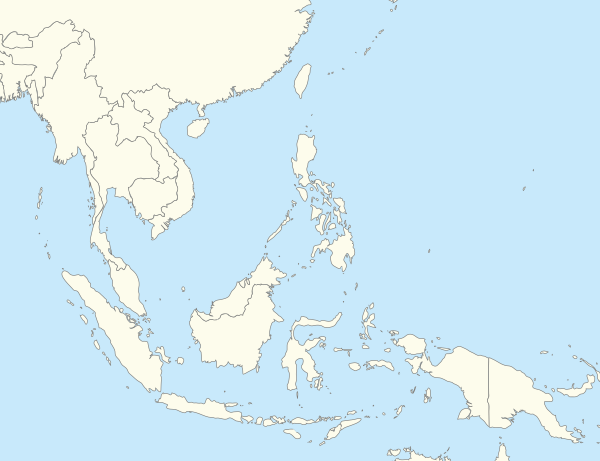Maritime Southeast Asia
| Geography | |
|---|---|
| Location | Overseas Indians and Sri Lankans |
Maritime Southeast Asia comprises the countries of Brunei, Indonesia, Malaysia, the Philippines, Singapore, and East Timor.[3]
The term Island Southeast Asia or Insular Southeast Asia is sometimes given the same meaning as Maritime Southeast Asia.[a] Other definitions restrict Island Southeast Asia to just the islands between mainland Southeast Asia and the continental shelf of Australia and New Guinea. There is some variability as to whether Taiwan is included in this. Peter Bellwood includes Taiwan in his definition,[5][b] as does Robert Blust,[c] whilst there are examples that do not.[d]
The 16th-century term "East Indies" and the later 19th-century term "Malay Archipelago" are also used to refer to Maritime Southeast Asia.
In Indonesia, the
Stretching for several thousand kilometres, the area features a very large number of islands and boasts some of the richest marine, flora and fauna biodiversity on Earth.
The main demographic difference that sets Maritime Southeast Asia apart from modern Mainland Southeast Asia is that its population predominantly belongs to Austronesian groups. The region contains some of the world's most highly urbanized areas—the Greater Manila Area, Greater Jakarta, Singapore, and Greater Kuala Lumpur—and yet a majority of islands in this vast region remain uninhabited by humans.
Geography
This section needs additional citations for verification. (February 2022) |
The land and sea area of Maritime Southeast Asia exceeds 2 million km2.[8] These are more than 25,000 islands of the area that comprise many smaller archipelagoes.[9]
The major groupings are:
The seven largest islands are Borneo, Sumatra, Sulawesi and Java in Indonesia; and Luzon and Mindanao in the Philippines.
In the natural sciences, the region is sometimes known as the Maritime Continent. It also corresponds to the biogeographical region of Malesia (not to be confused with "Malaysia"), with shared tropical flora and fauna.
Geologically, the archipelago is one of the most active volcanic regions in the world, producing many volcanoes, especially in Java, Sumatra, and the Lesser Sunda Islands region, where most volcanoes over 3,000 m (9,800 ft) are situated. Tectonic uplifts also produced large mountains, including the highest in Mount Kinabalu in Sabah, Malaysia, with a height of 4,095.2 m (13,436 ft) and Puncak Jaya on Papua, Indonesia at 4,884 m (16,024 ft). Other high mountains in the archipelago include Puncak Mandala, Indonesia at 4,760 m (15,620 ft) and Puncak Trikora, Indonesia, at 4,750 m (15,580 ft).
The climate throughout the archipelago is tropical, owing to its position on the Equator.
Biogeography
Island Southeast Asia is crossed by the Wallace Line. This line divides the flora and fauna of Asia from that of Australia and New Guinea with stretches of water that have always been too wide for plant and animal species to cross readily. The gaps are considered to be large enough to make accidental rafting from one side to another to be unlikely events. Apart from birds, species that have managed to cross this line include those that have been moved by humans. There is a transitional zone adjacent to the Wallace Line that is termed Wallacea. This is a zone where examples of animal and plant species from both sides can be found, but, particularly on smaller islands, there may be a greatly reduced number of terrestrial species.[5]: 1–15
The biographical division of the region is important for understanding the spread of both modern and archaic humans into the region. The Wallace Line represents a sea barrier that has persisted, as far as is known, even at the lowest sea levels of glacial maxima of the Pleistocene and the Holocene. Therefore we know when watercraft of some (admittedly unknown) description must have been used by humans to cross the sea.[5]: 15
Culture and demographics
As of 2017, there were over 540 million people living in the region, with the most populated island being
Historically, the region has been referred to as part of
History

The maritime connectivity within the region has been linked to it becoming a distinct cultural and economic area, when compared to the 'mainland' societies in the rest of Southeast Asia.
Ancient Indian Ocean trade

The first true maritime trade network in the Indian Ocean was by the
Maritime Silk Road
The ancient Austronesian trade networks was later used by the first Chinese trading fleets of the
Trade with China ceased after the collapse of the Song Dynasty due to invasions and famine. It was restored during the
Chinese trade was strictly controlled by the Imperial Court, but the Hokkien diaspora facilitated informal trade and cultural exchange with Southeast Asia, settling among Southeast Asian polities during this time period. Despite not having the official sanction of the Chinese government these communities formed business and trade networks between cities such as Melaka, Hội An and Ayutthaya.[23][24] Many of these Chinese businesspeople integrated into their new countries, becoming political officials and diplomats.[25]
See also
- Southeast Asia
- Brunei Darussalam–Indonesia–Malaysia–Philippines East ASEAN Growth Area
- Philippine archipelago
- Indonesian archipelago
- Farther India
- Greater India
- Greater Indonesia
- Maritime Continent
- Malay race
- Malay world
- Malesia
- Nanyang
- Peninsular Malaysia
- Domesticated plants and animals of Austronesia
Notes
- ^ For instance Tom Hoogervorst's chapter in The Routledge Handbook of Archeaology and Globalization: "I use Island Southeast Asia and Maritime Southeast Asia interchangeably."[4]
- ^ Bellwood's definition: "Island Southeast Asia includes Taiwan, the Philippines, Brunei and the Sarawak and Sabah provinces of East Malaysia (northern Borneo), and all of the islands of Indonesia to the west of New Guinea."
- ^ Robert Blust: "The major western island groups include the great Indonesian, or Malay Archipelago, to its north the smaller and more compact Philippine Archipelago, and still further north at 22 to 25 degrees north latitude and some 150 kilometres from the coast of China, the island of Taiwan (Formosa). Together these island groups constitute insular (or island) Southeast Asia."
- ^ "Island Southeast Asia (ISEA) comprises the tropical islands lying in between mainland East Asia and Taiwan to the northwest and Australia and New Guinea to the southeast."[6]
References
- ISBN 0-412-74040-0. Retrieved 30 November 2009.
- ^ Department of Economic and Social Affairs Population Division (2006). "World Population Prospects, Table A.2" (PDF). 2006 revision. United Nations. pp. 37–42. Archived from the original (PDF) on 2017-10-31. Retrieved 2007-06-30.
- ISBN 978-1589016262.; Nichiporuk, Brian; Grammich, Clifford; Rabasa, Angel; DaVanzo, Julie (2006). "Demographics and Security in Maritime Southeast Asia". Georgetown Journal of International Affairs. 7 (1): 83–91. Archivedfrom the original on 2020-08-15. Retrieved 2020-08-11.
- ISBN 9781315449005.
- ^ ISBN 9781119251552.
- . Retrieved 16 July 2023.
- S2CID 163375995.
- ]
- ^ Philippines: General Information. Government of the Philippines. Retrieved 2009-11-06; "World Economic Outlook Database" (Press release). International Monetary Fund. April 2006. Retrieved 2006-10-05.; "Indonesia Regions". Indonesia Business Directory. Archived from the original on 2005-12-28. Retrieved 2007-04-24. [verification needed]
- ^ Gaynor, Jennifer L. (2014). "Maritime Southeast Asia, Not Just a Crossroads". Education About Asia. 19 (2): 16. Archived from the original on April 25, 2021. Retrieved April 25, 2021.
- ^ Coedes, G. (1968) The Indianized States of Southeast Asia Edited by Walter F. Vella. Translated by Susan Brown Cowing. Canberra: Australian National University Press. Introduction... The geographic area here called Farther India consists of Indonesia, or island Southeast Asia....
- ^ See the cultural macroregions of the world table below.
- (PDF) from the original on 2021-01-17. Retrieved 2019-12-10.
- ^ ISBN 9783319338224. Archivedfrom the original on 2023-03-26. Retrieved 2020-11-27.
- )
- ^ ISBN 0415100542.
- ^ Doran, Edwin Jr. (1974). "Outrigger Ages". The Journal of the Polynesian Society. 83 (2): 130–140. Archived from the original on 2019-06-08. Retrieved 2019-07-14.
- ISBN 9780890961070.
- ^ Blench, Roger (2004). "Fruits and arboriculture in the Indo-Pacific region". Bulletin of the Indo-Pacific Prehistory Association. 24 (The Taipei Papers (Volume 2)): 31–50. Archived from the original on 2021-03-08. Retrieved 2019-07-14.
- OCLC 49820972.
- JSTOR 25165168.
- OCLC 16646158.
- ^ YOKKAICHI, Yasuhiro. "Chinese and Muslim Diasporas and Indian Ocean Trade under the Mongol Hegemony". Angela Schottenhammer[ed.] the East Asian Mediterranean: Maritime Crossroads of Culture, Commerce, and Human Migration. Wiesbaden: Otto Harrassowitz. Archived from the original on 2022-04-11. Retrieved 2018-07-29.
- S2CID 162282960.
- )
External links
- Art of Island Southeast Asia, a full text exhibition catalog from The Metropolitan Museum of Art

